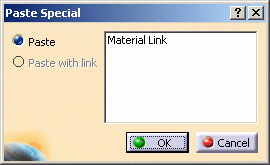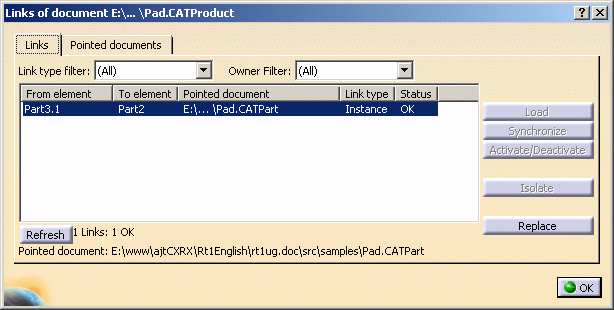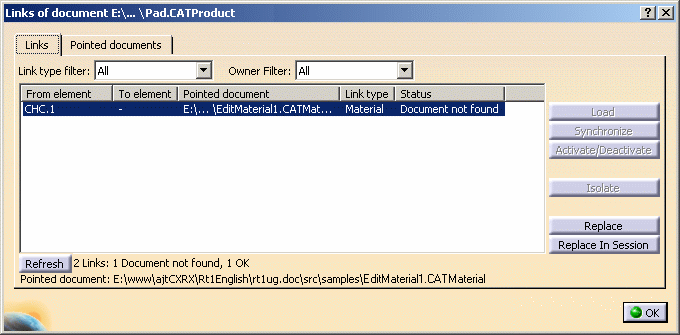- Material from a library:
The part is automatically updated to reflect any changes to the original material in the library. This is also useful in large assemblies if you have material specifications that may change and that you use in more than one place.
Materials can also be mapped as linked objects from libraries using the Link to file check box in the Library
dialog box. - Paste the material on a different part in the same document:
The link is made from the second part to the first part. Editing the material on either part automatically updates the material on the other part - Paste the material on parts in different documents:
Editing the material on any part automatically updates all linked materials on all parts in all documents. You can in this way change the material specifications in all places where they appear without having to edit each individual occurrence.
-
Select the material you want to copy from the EditMaterial1.CATMaterial library.
-
Copy the material. To do so, you can either:
- Click Copy
 in the Standard toolbar
in the Standard toolbar - Select Edit > Copy or
- Right-click then select Copy.
- Click Copy
-
Select the part onto which you want to map the material (Part2 in our example)
-
To paste, you can either:
- Select Edit > Paste Special... or
- Right-click then select Paste Special...
The Paste Special dialog box appears:

-
Select Material Link then click OK.
The material is mapped onto the selected part and the specification tree updated and a linked material  icon
identifies the material in the specification tree.
icon
identifies the material in the specification tree.
You cannot change the material name in the Feature Properties tab of the Properties dialog box. For detailed information about the Paste Special... command, refer to Using the Paste Special... command.
| Simple copy and paste as well as drag and drop operations can also be performed. In both cases, the mapped material is not linked. |
Managing Broken Links
-
Select Edit > Links... to open the Links dialog box:

-
Close the dialog box then move the document EditMaterial1.CATMaterial to another folder.
-
Restart your session, then reopen the document Pad.CATProduct.
The Open dialog box appears, explaining that the document EditMaterial1.CATMaterial was not found:

There are several reasons why a link with a material may no longer work: - the material has been deleted. In that case, the link cannot
be restored since the material has
been definitely lost - the material has been moved or renamed which means that it
exists but it is different from
the file pointed to. In that case, the pointed document is searched in:- the current session
- the directory of the loaded document
- the default material library. This library is defined in
the
CATStartupPathvariable or in the Material Libray subcategory (in Tools > Options > Infrastructure > Material Library).
When a link to a material is broken, the material icon is not displayed anymore in the specification tree. However, the link can still be seen when selecting Edit > Links or File > Desk and you can then restore the link manually. To do so, follow the steps below. - the material has been deleted. In that case, the link cannot
be restored since the material has
-
Click Close then select Edit > Links...:

-
Click the Pointed documents tab.
This activates the Find button and provides you with the path and name of the document pointed to in the session.
-
Click Find to open the File Selection dialog box, explore your file system to find the corresponding missing file, select it, then click Open.
Once the material has been found, the broken link icon is replaced with the linked material icon  in the
specification tree.
in the
specification tree.

The File Selection dialog box can be directly accessed from the Open dialog box (introduced in Step 3) either by double-clicking the file path inside the field or by clicking Desk.
In both cases, the Desk window opens and you just have to right-click the CATMaterial then select Find... which opens the File Selection dialog box.
-
Still in the Pointed documents tab, click Open. The Links dialog box disappears and EditMaterial1.CATMaterial opens.
-
Now, if you select Edit > Links with the EditMaterial1.CATMaterial document active, the Links dialog box indicates that the right material library has been found and loaded.
For more information on managing document links, refer to the Version 5 Infrastructure User's Guide.
Select File > Send To > Mail/Directory when you want to send a document to another person. This command enables you to check the various links existing between your documents and thus, to avoid broken links.
![]()